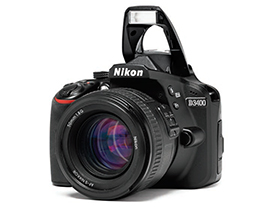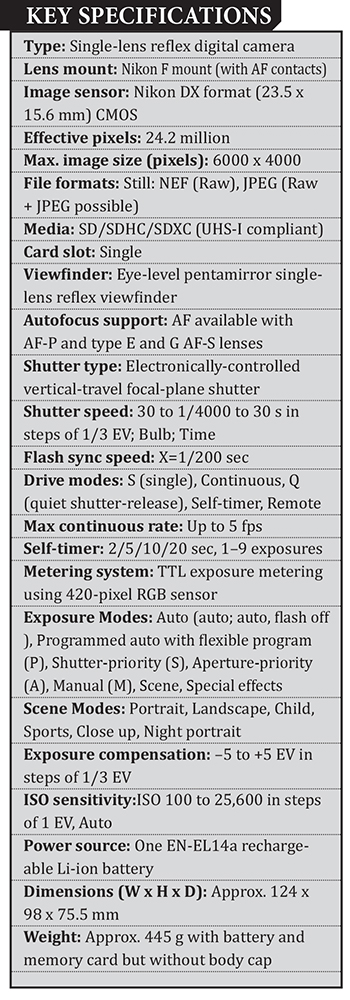 Ergonomics
Ergonomics
The D3400 is quite small and could be a little uncomfortable for people with medium to large hands. It has a nice rubber finish at the grip. The buttons are all easily accessible, but small. The display is still a fixed model. The viewfinder, though small, is comfortable to use. The selected focus point illuminates on achieving focus. There is no grid or level indicator in either the optical viewfinder or the monitor.
Performance
We tested the D3400 with an AF-S Nikkor50mm f/1.5G prime lens since Nikon was unable to provide the kit lens in time. The D3400 performed well with the lens. Images were quite sharp. Autofocus was slow compared to higher models, but at par with other budget cameras. We tested the 3400 with vignette control and distortion control turned On. The camera controlled darkening of corners like a champion. We did not observe any darkening even at f/1.4. Auto White Balance performed well with the camera producing colours true to the original under natural light. But under artificial light, it produced slight cast as expected, which was easily removable in post-processing.
The native print size is 20 x 13.33 inches at 300 ppi. At 25 percent of screen size, the images were absolutely free of noise up to ISO 3200. A tinge of noise was seen at ISO 6400, while ISO 12,800 was also usable. Blown up to 50 percent, the slight noise appeared from ISO 1600 onwards. However, the images were usable up to ISO 6400. Viewed at 100 percent, the images were noise-free up to ISO 400 and were usable up to ISO 1600. This is slightly better than D3300, though it is only a minor tweak.
The camera produced prominent flare and purple fringing and there is no correction available for this. In continuous mode, the 3400 shot 17 Raw images in a burst and took about 11 seconds to write them on a Sandisk Extreme Class 10 (UHS-I U3) card. In case of JPEGs, it shot 51 images in a burst and took , 22 seconds to write to the card. The camera kept the declared speed of 5 fps.
Value for Money
The Nikon D3400 body retails at an MRP of Rs.31,450, while the AF-P 18-55mm f/3.5-5.6G VR kit costs Rs.36,950. The double zoom kit with AF-P 18-55mm f/3.5-5.6G VR and AF-P 70-300mm f/4.5-6.3G ED VR carries a price tag of Rs.47,450. The body is more expensive than D3300 by Rs.7000, which is hardly justifiable, going by the rather stingy value addition. |SP
FINAL SCORE 77%
Design and Build Quality 16/20
Key Features 16/20
Ergonomics 16/20
Performance
Autofocus 3/5
Metering 5/5
Noise Control 4/5
Sharpness 4/5
LCD/EVF 3/5
Auto WB 4/5
Sub-Total 23/30
Value for Money 6/10
PLUS
• Good noise control
• Sensitivity boost up to ISO 25,600
MINUS
• No real improvement over D3300
• Flash output reduced
• Image Sensor Cleaning removed
• Increase in price
VERDICT
The D3400 is essentially the D3300 with a one stop digital boost of sensitivity along with Bluetooth and SnapBridge, while discarding ultrasonic dust removal and reducing the flash output by almost half. The bottle and the wine remains the same, but neatly packaged with a new label. In fact, with the removal of ultrasonic dust reduction and reduction in flash output along with the choice of Bluetooth to transfer heavy files, we are wondering whether it is an upgrade or downgrade.
Sujith Gopinath


